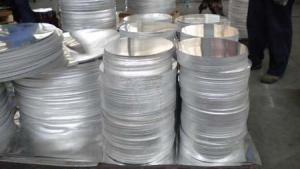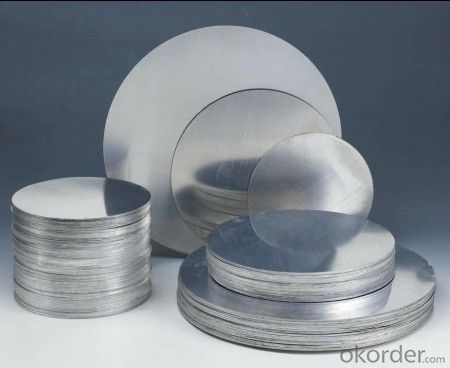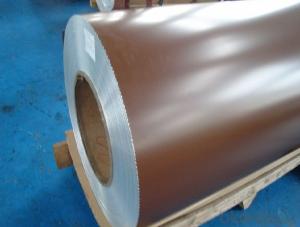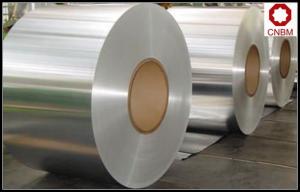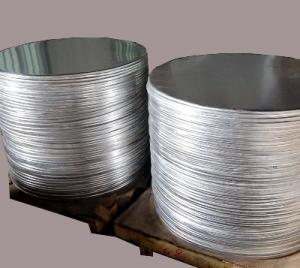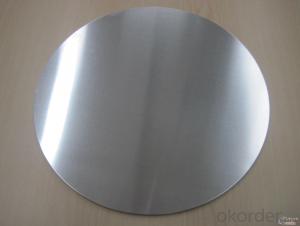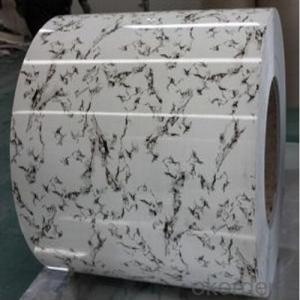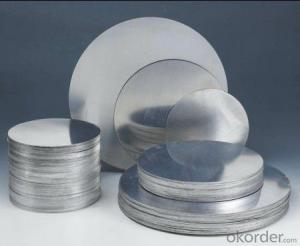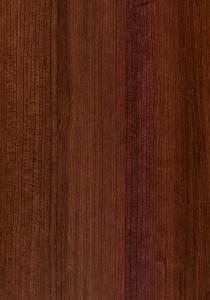Wood Grain Aluminum Coil Stock for High Quality Mill Finished Aluminum Circles in Cookware
- Loading Port:
- Shanghai
- Payment Terms:
- TT or LC
- Min Order Qty:
- 2 m.t.
- Supply Capability:
- 5000 m.t./month
OKorder Service Pledge
OKorder Financial Service
You Might Also Like
1.Structure of Mill Finished Aluminium Circle for Cookware with High Quality
Mill Finished Aluminium Circle for Cookware with High Quality is one semi-finished aluminium material. This strip can be rolled down to aluminium coil,sheet,circle ect. The alloy AA1050 is widly used in building, industry ect. Its weight is much lower than steel. So many customers choosed aluminium material instead of steel.
a.Competitive price---We have our own mills and can produce mill finished aluminium coils, so we can control the production cost better.
b.Professional after-sale service---We have more than 15 years exportation experience and you need not worry about the exporation problems.
c.Fast delivery time---We can control the delivery time within 35 days.
3. Image
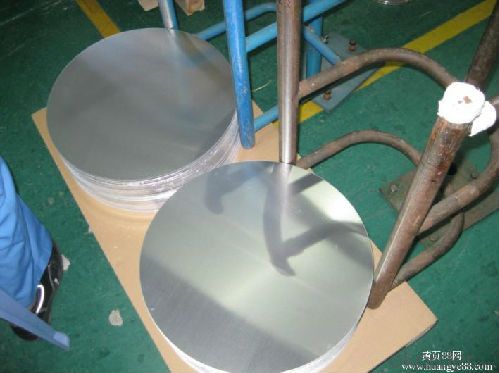

4. Product Specification
. 5.FAQ: ALLOY Temper Thickness Diameter Weight AA1050 H14 0.2MM-3MM 100MM-1000MM 2 TONS
What is the quality standard?
---Usually our standard is GB3880-2006
What is the largest width?
---It is 2300mm
What is the MOQ?
---Usually we can accept 80 tons.
- Q: when ferrous sulfate is poured into an aluminium can, holes appear in the can. Why?
- aluminum reacts via a redox reaction with iron(II): 3 Fe2+(aq) + 2 Al(s) --- 3 Fe(s) + 2 Al3+(aq)
- Q: The temperature of the water drops from 93.0°C to 78.0°C. What quantity of heat energy did the piece of aluminum absorb?
- The specific heat of Aluminum is 0.215 cal/g-°C. The calories absorbed (q) would be q = m * c * (T2 -T1) = 22.0 g * 0.215 cal/g-°C * (78.0 °C - 0.3 °C) If you have a different value for the Specific heat of Aluminum, use it in the formula for your calculations. If you knew the mass of the water, you could check your calculations because the heat gained by the Al would be equal to the heat lost by the water, using q = m * c * (T2 -T1), where m is the mass of the water, c = 1.00 calorie/gram °C, T2 = 78.0 °C and T1 = 93.0 °C. The sign of q will be negative.
- Q: How do aluminum coils contribute to energy-efficient lighting?
- The energy efficiency of lighting systems is greatly enhanced by aluminum coils. The exceptional thermal conductivity of aluminum coils is the main advantage when used in lighting applications. Due to its high thermal conductivity, aluminum can effectively transfer heat away from the light source and disperse it into the surroundings. This property prevents lighting fixtures from overheating and ensures the longevity and efficiency of the entire system. Furthermore, aluminum coils are lightweight and have a high strength-to-weight ratio, making them perfect for creating compact and durable lighting fixtures. By utilizing aluminum coils, manufacturers can design and produce lighting products that are lighter and more efficient, thereby reducing overall energy consumption. Additionally, aluminum coils have a high reflectivity, allowing them to efficiently distribute and reflect light. This characteristic results in better light output and ensures that a larger portion of the emitted light is effectively utilized, thereby reducing energy waste. Moreover, aluminum is a highly recyclable material that can be reused and repurposed multiple times without losing its qualities. This recyclability contributes to the overall sustainability of energy-efficient lighting systems, reducing the environmental impact associated with their production and disposal. To sum up, aluminum coils contribute to energy-efficient lighting by effectively dissipating heat, reducing energy consumption through lightweight designs, optimizing light distribution, and promoting sustainability through recyclability.
- Q: What is an aluminum coil?
- An aluminum coil is a continuous strip or sheet of aluminum that is wound into a coil shape. It is typically used in various industries for its lightweight, corrosion-resistant, and malleable properties. The coil is produced through a process called continuous casting and rolling, where molten aluminum is poured into a caster and then rolled between large metal rollers to achieve the desired thickness and shape. Aluminum coils are commonly used in the manufacturing of automotive parts, building materials, electrical equipment, and packaging materials. They can be further processed into different forms, such as sheets, plates, or foils, depending on the specific application requirements.
- Q: What are the color options available for aluminum coils?
- The color options available for aluminum coils are vast and varied. Aluminum coils can be coated with a wide range of colors through a process called coil coating. This process involves applying a layer of paint or coating to the aluminum surface to enhance its appearance and provide additional protection against corrosion and weathering. Some common color options for aluminum coils include white, black, gray, silver, bronze, and metallic finishes. Additionally, custom colors can also be created to match specific design preferences or brand requirements. These custom colors can be achieved through a color matching process where the desired color is formulated and then applied to the aluminum coils. It is worth noting that the availability of color options may vary depending on the manufacturer and supplier. However, with the advancement in coil coating technology, the range of color choices for aluminum coils has significantly expanded, allowing for greater flexibility in design and aesthetics.
- Q: Are aluminum coils applicable in the manufacturing process of automobiles?
- <p>Yes, aluminum coils are widely used in automobile manufacturing. They are utilized in various components such as engine parts, body panels, and wheels due to their lightweight, corrosion resistance, and strength. Aluminum's recyclability and energy efficiency also make it an environmentally friendly choice for the automotive industry.</p>
- Q: When the aluminum roll is rolled 0.14, when the coil is taken off, what happened to the loose layer?
- I think the 0.14mm is certainly not the aluminum coil lining sleeve forgot, then the biggest doubt is the oil removal effect is not good, with rolling after the aluminum layer between the leakage for aluminium roll support is not enough, the collapse of the volume, the specific performance is the edge of the circular aluminum layer was uniform into ripples;
- Q: What are the potential health risks associated with aluminum coils?
- Aluminum coils are commonly used in HVAC systems for their durability and heat transfer properties. While they are generally considered safe, there are potential health risks associated with aluminum coils if certain conditions are not met. One of the primary concerns is the potential for aluminum to leach into the air or water supply. Aluminum is a known neurotoxin, and excessive exposure to it can lead to various health issues, particularly in individuals with pre-existing conditions such as kidney disease or weakened immune systems. However, the amount of aluminum that may leach from coils is typically minimal and unlikely to pose a significant risk to most people. Another potential health risk is related to the accumulation of dust, dirt, and other particles on the aluminum coils. These particles can act as a breeding ground for bacteria, mold, and other allergens, which may negatively affect indoor air quality. If not properly maintained and cleaned, these contaminants can cause respiratory problems, allergies, and even infections in susceptible individuals. Furthermore, aluminum coils can be a source of electromagnetic fields (EMFs) due to the electric currents passing through them. While the health effects of EMF exposure are still a topic of ongoing research, some studies suggest a potential link between high levels of EMFs and certain health conditions, including cancer. However, it is important to note that the levels of EMFs emitted by aluminum coils are generally considered to be within safe limits and unlikely to pose significant health risks. To mitigate these potential health risks, it is crucial to ensure proper maintenance and cleaning of aluminum coils. Regular inspections, professional cleaning, and changing air filters can help prevent the accumulation of contaminants and maintain good indoor air quality. It is also recommended to consult with HVAC professionals to ensure proper installation and maintenance of the coils, minimizing the risk of aluminum leaching or excessive EMF exposure. In conclusion, while there are potential health risks associated with aluminum coils, they are generally considered safe when properly maintained. Taking necessary precautions and following recommended maintenance practices can help minimize any potential health concerns associated with aluminum coils in HVAC systems.
- Q: Can aluminum coils be used for heat sinks?
- Yes, aluminum coils can be used for heat sinks. Aluminum is a popular choice for heat sinks due to its excellent thermal conductivity properties. Heat sinks are designed to dissipate heat generated by electronic components, such as processors or power transistors, to prevent overheating and ensure optimal performance. Aluminum coils can effectively transfer heat away from the heat source and distribute it over a larger surface area, allowing for efficient heat dissipation. Additionally, aluminum is lightweight, corrosion-resistant, and cost-effective, making it a suitable material for heat sink applications.
- Q: How do aluminum coils contribute to reduced carbon emissions?
- There are several ways in which aluminum coils help reduce carbon emissions. To begin with, aluminum is a lightweight material, unlike other metals such as steel. This means that less energy is needed to transport and handle aluminum coils. The reduced weight leads to lower fuel consumption during transportation, ultimately resulting in decreased carbon emissions. Moreover, the production of aluminum coils requires significantly less energy compared to other metals. Aluminum is highly recyclable and can be melted down and reused without losing its original properties. This recycling process only requires a fraction of the energy needed to produce aluminum from raw materials, resulting in reduced greenhouse gas emissions. In addition, aluminum coils have excellent thermal conductivity. This allows for improved energy efficiency in various applications. For instance, aluminum coils are commonly used in HVAC systems, where they help transfer heat more effectively. This reduces the energy required for heating or cooling, ultimately leading to lower carbon emissions. In summary, the lightweight nature of aluminum coils, their recyclability, and their improved energy efficiency all contribute to reduced carbon emissions. By utilizing aluminum coils in different industries, we can minimize environmental impact, conserve energy resources, and mitigate climate change.
Send your message to us
Wood Grain Aluminum Coil Stock for High Quality Mill Finished Aluminum Circles in Cookware
- Loading Port:
- Shanghai
- Payment Terms:
- TT or LC
- Min Order Qty:
- 2 m.t.
- Supply Capability:
- 5000 m.t./month
OKorder Service Pledge
OKorder Financial Service
Similar products
Hot products
Hot Searches
Related keywords
